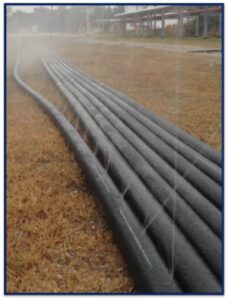 Horizontal air sparging is one of the most effective methods to remediate certain types of subsurface contamination. Read on to learn more about how air sparging is used, why horizontal wells are frequently chosen to implement air sparging, and how your contaminated site may benefit from evaluating horizontal air sparge.
Horizontal air sparging is one of the most effective methods to remediate certain types of subsurface contamination. Read on to learn more about how air sparging is used, why horizontal wells are frequently chosen to implement air sparging, and how your contaminated site may benefit from evaluating horizontal air sparge.
How Does Air Sparging Remediate Contaminated Soil and Groundwater?
Air Sparging involves the injection of air into the saturated zone of the subsurface. Air sparging reduces concentrations of volatile and semi-volatile compounds found in the soil and groundwater. The air can convert contaminants from the dissolved phase to the vapor phase through air stripping and can stimulate beneficial microbial activity. Through the processes of volatilization, aerobic biodegradation, and solubilization, air sparging can reduce contaminant concentrations. If the contaminants are volatile or biodegradable, they can be potentially remediated using air sparging. Air sparging and Soil Vapor Extraction (SVE) is often used jointly to enhance remediation performance or prevent soil vapors from affecting building interiors above the contaminant plume. Typical air sparging equipment includes the use of a compressor or blower; however, the air sparge wells used to deliver the air to the subsurface are the most important component of an air sparge system. Air sparging is an effective treatment for various common types of contamination associated with petroleum and chlorinated solvents.
What Are the Advantages of Using Horizontal Air Sparging?
Vertical wells are the most common method to install an air sparge remediation system. However, various site limitations can make vertical wells challenging to implement effectively. Common site conditions which limit the efficacy of vertical wells include lack of access to the area above the plume due to infrastructure or sensitive areas, industrial, commercial, residential uses of the property which cannot easily tolerate interruptions during remedial construction, and O&M, challenging geology, and future site redevelopment. Horizontal remediation wells are frequently utilized to overcome these site conditions and install air sparge systems. Unlike conventional vertical remediation wells, horizontal remediation wells can access the contaminant plume from almost anywhere through the use of directional drilling techniques. Not only do horizontal remediation wells allow you to access the plume, but they are also far more effective at cleaning up contamination. Horizontal remediation wells allow significantly more well screen to be placed within the plume, allowing for more efficient air delivery to wider subsurface areas. They can also be precisely targeted to focus on problematic hot spots. The resulting radius of influence that horizontal remediation wells can achieve allows for enhanced remediation performance and less time to meet cleanup goals.
Air sparging is an effective way to reduce various common types of contamination. Horizontal air sparge techniques are proven to provide the most effective implementation of air sparge remediation by providing unparalleled access to the contaminant plume and enhanced reduction of contaminant concentrations. If you have a contaminated site that could benefit from horizontal air sparge, please click HERE to tell us about your project so that we can help you determine whether horizontal air sparge may be a practical solution.